Nutritional status deteriorates as the severity of diabetic foot ulcers increases and independently associates with prognosis
- PMID: 23251271
- PMCID: PMC3524099
- DOI: 10.3892/etm.2012.780
Nutritional status deteriorates as the severity of diabetic foot ulcers increases and independently associates with prognosis
Abstract
The prognosis for diabetic foot ulcers (DFUs) remains poor. Nutritional status has not been identified as one of the factors affecting the outcome of DFUs. Therefore, indicators correlated with nutritional status and outcome were analyzed to investigate their relationship. A total of 192 hospitalized patients with Wagner grade 1-5 ulcers and 60 patients with Wagner grade 0 ulcers (all had type 2 diabetes) were assessed by the following: subjective global assessment (SGA), anthropometric measurements, biochemical indicators and physical examinations to evaluate nutritional status, severity of infection and complications. Patient outcome was recorded as healing of the ulcer and the patients were followed up for 6 months or until the wound was healed. The percentage of malnutrition was 62.0% in the DFU patients. The SGA was closely correlated with infection (r=0.64), outcome (r=0.37) and BMI (r=-0.36), all P<0.001. The risk of poor outcome increased with malnutrition [odds ratio (OR), 10.6, P<0.001]. The nutritional status of the DFU patients was independently correlated with the severity of infection and outcome (both P<0.001) and Wagner grades and nutritional status (SGA) were independent risk factors for patient outcome (both P<0.001). Nutritional status deteriorated as the severity of the DFU increased, and malnutrition was a predictor of poor prognosis.
Figures


References
-
- Pan XR, Yang WY, Li GW, Liu J. Prevalence of diabetes and its risk factors in China, 1994. National Diabetes Prevention and Control Cooperation Group. Diabetes Care. 1997;20:1664–1669. - PubMed
-
- Yang W, Lu J, Weng J, et al. Prevalence of diabetes among men and women in China. N Engl J Med. 2010;362:1090–1101. - PubMed
-
- Boulton AJ, Vileikyte L, Ragnarson-Tennvall G, Apelqvist J. The global burden of diabetic foot disease. Lancet. 2005;366:1719–1724. - PubMed
-
- Tabatabaei Malazy O, Mohajeri-Tehrani MR, Pajouhi M, Shojaei Fard A, Amini MR, Larijani B. Iranian diabetic foot research network. Adv Skin Wound Care. 2010;23:450–454. - PubMed
LinkOut - more resources
Full Text Sources
Medical
